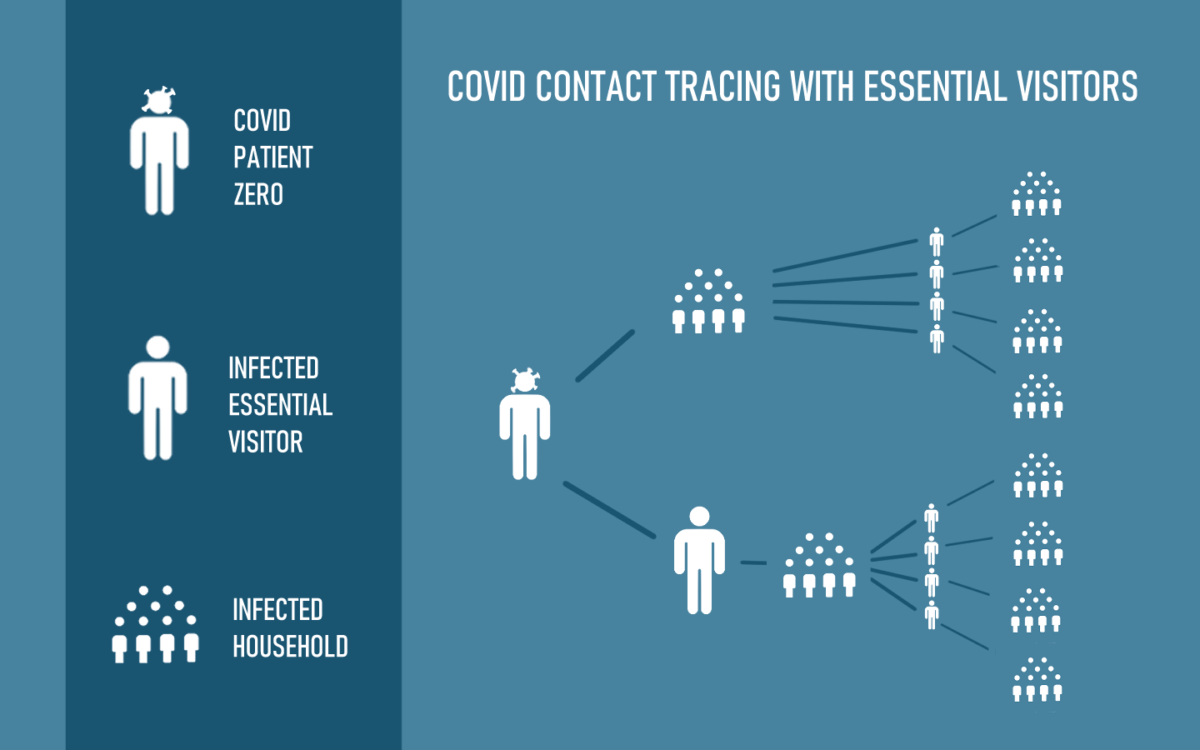Students currently living on campus can register an essential visitor who does not count toward the eight-person maximum for “households.” The University began allowing students to form “households” and register essential visitors after Santa Clara County’s COVID-19 risk assessment moved to the purple tier. According to the University, the essential visitor system was established to allow students access to necessary support while prioritizing the health and safety of the broader community. But in practice, the system may pose challenges for Stanford in its ability to prevent the spread of COVID-19.
Essential visitors can be individuals from another on-campus household in a different residence building, or they can live off-campus. To qualify as essential visitors, these individuals can be care providers (home care workers who provide essential services such as health or childcare), spouses, partners or dependent children. Once essential visitors are registered, they receive an email indicating that they are allowed to conduct business essential to the University. There is no formal vetting process for essential visitors. Instead, students fill out a form with the name and role of their visitor, and their visitor is automatically approved.
While the system is intended to limit the spread of COVID-19 while allowing students to socialize safely, it raises some challenges. Matthew Mimiaga, a professor at the University of California, Los Angeles School of Public Health, said that the household system does limit the spread of the virus and that it does “make good sense.” But, he advised students to keep their guard up: “the only way to stay safe is to stay at home and only physically interact with people in your household system but ensure that they, too, are not physically interacting with anyone outside the household,” he said.
In practice, each essential visitor has access to an on-campus household of eight people, who each might have their own essential visitor and household. If an essential visitor becomes infected, the infection can spread from the visitor to household members and then to all social pods with which household members are in contact.

(Model of the potential spread of COVID-19 through essential visitors and on-campus social pod system.)
But according to University spokesperson Pat Harris, social pods and the essential visitor system do not threaten Stanford’s attempt to limit the spread of COVID-19 because “most essential visitors’ exposure to students is limited.”
Harris explained that this is partly due to the University’s ability to conduct contact tracing when social pods and essential visitors are registered.
“If an essential visitor tests positive for COVID and the university is notified, the household and visitors registration processes help the University identify close contacts, who then receive exposure notifications,” she wrote.
Dean Winslow, a professor at the School of Medicine, told The Daily that the essential visitor system is “potentially a problem.” When asked to clarify, Winslow wrote that “allowing any exceptions (essential visitors from outside) to a singular ‘pod’ has the potential of introducing infection. However, there are some practical limits in place that mitigate the risk.” He also wrote that preventing parents from seeing their children could be psychologically damaging to both parents and their children.
Winslow added that the essential visitor system “clearly reduces the risk of transmission on campus and in our hospitals, and when an exposure/infection occurs, it makes it easier to trace.”
“The frequent testing that all Stanford students and staff undergo provides an early warning of sorts,” Winslow wrote. But ensuring that all students follow testing protocols is challenging — in October, The Daily reported that 19% of students may not have been in compliance with the University’s on-campus testing program.
While some students on-campus are trying to adhere to the essential visitor system, some have found its guidelines hard to follow. One student, who requested anonymity because their actions violated the Campus Compact, told The Daily that they have tried to minimize the risk of spread by having their essential visitor, who lives off-campus, stay with them on campus for extended periods of time, even though they know it violates the Campus Compact.
The student explained that they think this strategy is safer than having small repeated visits given the risk of contact spread, especially because their essential visitor has their own off-campus household.
Another student, who requested anonymity for the same reason, told The Daily that they are in a six-person household in which multiple members have essential visitors from both on and off-campus. The student also said they often socialize with others outside their household in their room, common spaces and outdoors. They said they were unsure about the number of people that the other members of their household and essential visitors came in contact with.
On-campus gatherings and movement among households and essential visitors pose serious challenges to on-campus contact tracing. These problems are more immediate now that up to three households can gather with each other.
Santa Clara County’s Public Health Department did not respond to multiple requests for comment on the implications of the essential visitor system.
This article has been updated to include a more complete picture of the statement provided by Matthew Mimiaga, including his comment that Stanford’s essential visitor system does “make good sense.”
